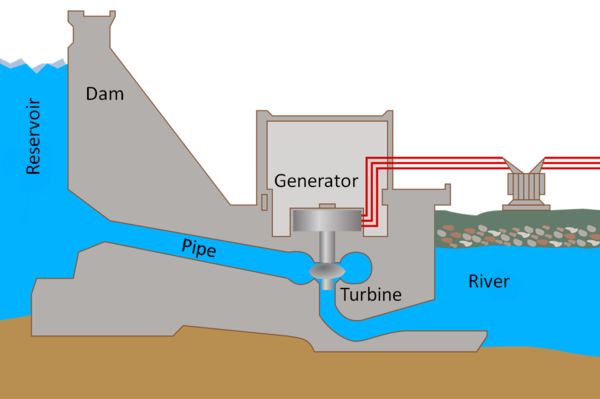Difference between revisions of "Hydroelectric"
| Line 67: | Line 67: | ||
*Blocks the migration of some river species. | *Blocks the migration of some river species. | ||
*Can only be built in certain locations. | *Can only be built in certain locations. | ||
| + | |||
| + | ===References=== | ||
| + | ====AQA==== | ||
| + | |||
| + | :[https://www.amazon.co.uk/gp/product/1782946403/ref=as_li_tl?ie=UTF8&camp=1634&creative=6738&creativeASIN=1782946403&linkCode=as2&tag=nrjc-21&linkId=32a0abb60dff015b15b50e9b1d7b4644 ''Hydroelectic power, page 50, GCSE Combined Science Trilogy; Physics, CGP, AQA ''] | ||
| + | :[https://www.amazon.co.uk/gp/product/1782945598/ref=as_li_tl?ie=UTF8&camp=1634&creative=6738&creativeASIN=1782945598&linkCode=as2&tag=nrjc-21&linkId=ad276ad49df77ab4b40ab4fd0fe09992 ''Hydroelectric power, page 177, GCSE Combined Science; The Revision Guide, CGP, AQA ''] | ||
| + | :[https://www.amazon.co.uk/gp/product/1471851370/ref=as_li_tl?ie=UTF8&camp=1634&creative=6738&creativeASIN=1471851370&linkCode=as2&tag=nrjc-21&linkId=01c69b0ae058f809cf636033e6ba793e ''Hydroelectric power, page 24, GCSE Physics, Hodder, AQA ''] | ||
| + | :[https://www.amazon.co.uk/gp/product/1471851354/ref=as_li_tl?ie=UTF8&camp=1634&creative=6738&creativeASIN=1471851354&linkCode=as2&tag=nrjc-21&linkId=9012a0d354024419214fb3ad5ac44ba0 ''Hydroelectric power, page 279, GCSE Combined Science Trilogy 1, Hodder, AQA ''] | ||
| + | :[https://www.amazon.co.uk/gp/product/1782945970/ref=as_li_tl?ie=UTF8&camp=1634&creative=6738&creativeASIN=1782945970&linkCode=as2&tag=nrjc-21&linkId=a120d24dcc7cc7a58192069a3aafc1d2 ''Hydroelectric power, page 52, GCSE Physics; The Complete 9-1 Course for AQA, CGP, AQA ''] | ||
| + | :[https://www.amazon.co.uk/gp/product/178294558X/ref=as_li_tl?ie=UTF8&camp=1634&creative=6738&creativeASIN=178294558X&linkCode=as2&tag=nrjc-21&linkId=f0dfb66dafcb0c6e9449e7b1a4ae1ac242 ''Hydroelectric power, pages 18, 20, GCSE Physics; The Revision Guide, CGP, AQA ''] | ||
| + | :[https://www.amazon.co.uk/gp/product/0008158770/ref=as_li_tl?ie=UTF8&camp=1634&creative=6738&creativeASIN=0008158770&linkCode=as2&tag=nrjc-21&linkId=ec31595e720e1529e49876c3866fff6e ''Hydroelectric power, pages 32-3, 41, GCSE Physics; Student Book, Collins, AQA ''] | ||
| + | :[https://www.amazon.co.uk/gp/product/019835939X/ref=as_li_tl?ie=UTF8&camp=1634&creative=6738&creativeASIN=019835939X&linkCode=as2&tag=nrjc-21&linkId=57e96876985fc39b1a3d8a3e3dc238b6 ''Hydroelectric power, pages 38-39, GCSE Physics; Third Edition, Oxford University Press, AQA ''] | ||
Revision as of 17:59, 6 November 2019
Contents
Key Stage 3
Meaning
Hydroelectricity is an energy resource that uses the water flowing in rivers to generate electricity.
About Hydroelectricity
- Hydroelectricity is a renewable energy resource.
- Hydroelectricity has energy in the gravitational potential energy store of water that is flowing downhill.
Power
Hydroelectricity can be used to generate electricity.
| A diagram of a hydroelectric dam. |
- 1. Water flowing down a river is held back by a dam making a large reservoir.
- 2. Some water is allowed through pipes to flow downhill.
- 3. This water turns a turbine as it falls.
- 4. The turbine causes a generator to spin.
- 5. The generator makes an electrical current.
Advantages
- Reliable source as it is built in places that do not suffer drought.
- Power provided can change at a moments notice by allowing more water through the turbines.
- Low running costs and no fuel cost.
Disadvantages
- Expensive to build.
- Require the flooding of a large area of land.
- Destroys habitat of some creatures.
- Blocks the migration of some river species.
- Can only be built in certain locations.
Key Stage 4
Meaning
Hydroelectricity is an energy resource that uses the water flowing in rivers to generate electricity.
About Hydroelectricity
- Hydroelectricity is a renewable energy resource.
- Hydroelectricity has energy in the gravitational potential energy store of water that is flowing downhill.
Power
Hydroelectricity can be used to generate electricity.
| A diagram of a hydroelectric dam. |
- 1. Water flowing down a river is held back by a dam making a large reservoir.
- 2. Some water is allowed through pipes to flow downhill.
- 3. This water turns a turbine as it falls.
- 4. The turbine causes a generator to spin.
- 5. The generator makes an electrical current.
Advantages
- Reliable source as it is built in places that do not suffer drought.
- Power provided can change at a moments notice by allowing more water through the turbines.
- Low running costs and no fuel cost.
Disadvantages
- Expensive to build.
- Require the flooding of a large area of land.
- Destroys habitat of some creatures.
- Blocks the migration of some river species.
- Can only be built in certain locations.
References
AQA
- Hydroelectic power, page 50, GCSE Combined Science Trilogy; Physics, CGP, AQA
- Hydroelectric power, page 177, GCSE Combined Science; The Revision Guide, CGP, AQA
- Hydroelectric power, page 24, GCSE Physics, Hodder, AQA
- Hydroelectric power, page 279, GCSE Combined Science Trilogy 1, Hodder, AQA
- Hydroelectric power, page 52, GCSE Physics; The Complete 9-1 Course for AQA, CGP, AQA
- Hydroelectric power, pages 18, 20, GCSE Physics; The Revision Guide, CGP, AQA
- Hydroelectric power, pages 32-3, 41, GCSE Physics; Student Book, Collins, AQA
- Hydroelectric power, pages 38-39, GCSE Physics; Third Edition, Oxford University Press, AQA
